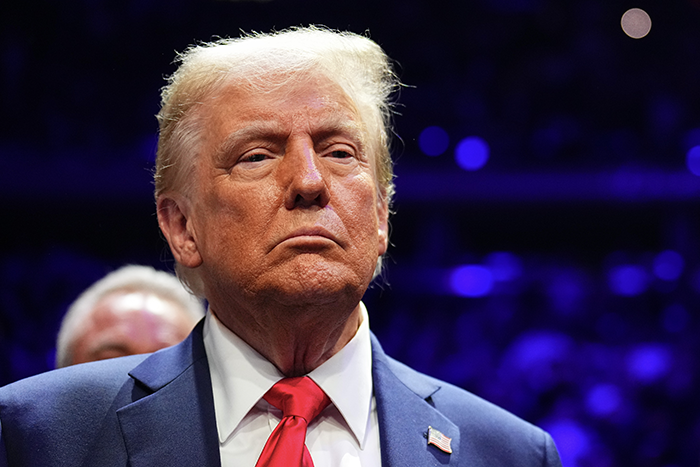Analyses / Geopolitical Observatory of the Indo-Pacific
12 December 2024
A New Trump Presidency: What Are the Prospects for Alliances and Minilateral Cooperation in the Indo-Pacific?

The Indo-Pacific was an undeniable priority during Donald Trump’s first presidency. It was he who, with a certain degree of foresight, adopted the terminology proposed by then-Japanese Prime Minister Shinzo Abe, making it the epicentre of U.S. foreign policy and a key element of a strongly anti-China narrative. However, the transactional logic favoured by Donald Trump did not spare his key regional partners, including those who shared his vision of a “free and open” Indo-Pacific.
Donald Trump’s return to power in January 2025 has therefore sparked fears and questions, not only among his two major allies, Japan and South Korea, but also in China. Japanese Prime Minister Shigeru Ishiba announced that he would have “frank discussions” with Donald Trump. As for South Korean President Yoon Suk-yeol, while he may fear a new American initiative towards North Korea, he is also cornered by a severe domestic political crisis following his disastrous attempted “coup d’état” in early December. For its part, China is concerned about a resurgence of trade and tariff wars that could further weaken its already fragile economy, while also speculating on the future of U.S. support for Taiwan.
The traditional U.S. partners in the region (Australia, Japan, South Korea, Taiwan) congratulated the president-elect, expressing their hope for strengthened relations with Washington. However, they are deeply worried that his return might undermine the Biden administration’s efforts to build a coherent and resilient regional security architecture.
Will the mechanisms of regional cooperation in the Indo-Pacific, notably AUKUS and the Quad, withstand another Donald Trump presidency? Will he come to understand the importance of “smart power” for 21st-century geopolitics?
The reorganisation of American power resources in the Indo-Pacific in response to China
In recent years, China’s rise and the prominence of its anti-access strategy in the Indo-Pacific have led to the strengthening of existing security agreements and mechanisms, as well as the search for new minilateral frameworks between the United States and its partners. Rivalry with China has been the primary challenge identified by the United States since the Obama administration and its “pivot” to Asia. In the foreword to the National Security Strategy published by his administration in 2017, President Trump, in his first year in office, referred to a “new era of competition,” while the document identified China as a “revisionist power” aiming to push the United States out of Asia.
The U.S. Indo-Pacific strategy adopted in 2019, along with the renaming of the U.S. command for the region from USPACOM to USINDOPACOM, underscores the strategic priority Washington has placed on a maritime Asia stretching from the Indian Ocean to the Pacific. It also highlights its determination to maintain an order based on respect for international law and norms, particularly the freedom of navigation and overflight. Trump’s first administration, from 2017 to 2021, sought to counter China through intensified competition, particularly in military, economic, and trade domains. It reorganised alliances and partnerships to develop a networked architecture capable of ensuring free access to the global commons, including maritime spaces.
The Biden administration has intensified strategic competition with China, adding a focus on technology, the importance of innovation, and the decoupling of supply chains. According to the U.S. National Security Strategy published in 2022, the People’s Republic of China is the “sole competitor” with the intent to reshape the international order and possesses all the economic, diplomatic, military, and technological capacities to achieve this ambition.
The Biden presidency has reinforced bilateral alliances with Japan, South Korea, Australia, and the Philippines. It has re-engaged with ASEAN, particularly within ADMM+ (the ASEAN Defence Ministers’ Meeting Plus), and focused on two specific security mechanisms: the Quad and AUKUS.
The question now is whether Trump will continue this momentum of revitalising alliances and innovating new partnership practices.
The development of innovative strategic frameworks
The Quad and AUKUS are two specific mechanisms designed to enhance the operational posture and projection capabilities of the United States and its allies across the Indo-Pacific theatre, with a more pronounced focus on the Western Pacific. They bring together the core group of regional maritime powers, including Japan, India, Australia, and the United Kingdom.
Established in 2004 in the aftermath of a devastating tsunami in the Indian Ocean, the Quad (Quadrilateral Security Dialogue) initially focused on maritime security cooperation, particularly in humanitarian assistance and disaster relief. Over time, its scope expanded to include thematic issues such as cybersecurity, infrastructure, and economic cooperation. The Biden administration significantly bolstered the operational nature of the Quad by creating working groups and instituting an annual summit for heads of state and government.
AUKUS, a security pact concluded in 2021 between the United States, the United Kingdom, and Australia, ensures close military and industrial cooperation among its members. It includes plans for the Australian Navy to acquire eight nuclear-powered submarines of U.S. origin.
Other important “minilateral” frameworks in the region include the Trilateral Security Dialogue between the United States, Japan, and Australia, which has been in place for seven years, and the trilateral dialogue between the United States, Japan, and South Korea, initiated at Camp David in August 2023. The advantage of such minilateralism—or the formation of small groups of allies—is that it enables targeted and therefore more effective collaboration on specific security issues among like-minded partners.
However, the future of these agreements and arrangements appears uncertain under the new Trump administration, given that his first term was marked by an unpredictable and sometimes harsh Asia policy, even towards Washington’s closest allies such as Japan and South Korea. Regarding the Quad, Donald Trump may find himself disappointed with India, a partner sought by the U.S. to counterbalance China but whose policy of multi-alignment remains highly ambiguous.
As for AUKUS, the construction programme has faced delays, costs are rising for Canberra, and American shipyards have proven unable to build the promised number of submarines within reasonable timeframes. Donald Trump might decide to address these issues in his own way, potentially scaling back certain aspects of U.S. commitments. Taiwan itself, with the question of continued U.S. military guarantees, is also under scrutiny.
Concerns about Donald Trump’s approach to alliances and partnerships in the Indo-Pacific are particularly acute, given the unprecedented security developments in the region over the past two years. Many coastal nations, as well as European powers, are rightly alarmed by the increasing maritime tensions involving Chinese forces, whether in the South China Sea or the Taiwan Strait. They are also highly aware of the new threats posed by closer ties between China and Russia, as well as between Russia and North Korea, which destabilise regional and international balances.
In fact, interactions between European and Asian security systems have never been more critical, particularly since North Korea has been supplying ammunition and weapons to Russian forces engaged in the war of aggression in Ukraine and, notably, sending soldiers to fight alongside them. Additionally, countries like Japan and South Korea have significantly strengthened their ties with NATO and are supporting Ukraine through humanitarian, medical, and economic assistance.
The Limits of the Return of “America First” in a 21st Century in Crisis
First” policy, may once again clash with the historical tradition of American engagement and active multilateralism that has characterised U.S. foreign policy since World War II—a dimension the Biden administration sought to restore. This misunderstanding of the global nature of Washington’s leadership and the importance of forward positioning and advanced bases for American forces was evident during Trump’s first presidency. It manifested in demands for increased contributions to the cost of stationing U.S. forces in South Korea and Japan. Similarly, there was a cooling of relations between the United States and both the European Union and NATO, whose members were accused of insufficient contributions to the Alliance’s military efforts. Finally, there was an unproductive rapprochement with North Korea, undermining South Korea’s security interests.
Furthermore, Trump’s confrontational approach towards China did nothing to diminish its capabilities. On the contrary, the result of these measures was a weakening of American diplomacy. Trump’s first presidency was marked by a profound misunderstanding of the roots of American power—what has enabled the U.S. to sustain a certain degree of asymmetry in its relationships with many other countries. It conflated the notions of strength and power in its dealings with other states, including close partners.
Even though the economic gap between China and the United States is narrowing, the U.S. still retains superior capabilities and hard power, partly due to its network of alliances and partnerships. However, its influence, built on liberal norms, is suffering the effects of a skilful information war conducted by both China and Russia. At this stage, despite an ideological renewal attempt through the concept of a “free and open” Indo-Pacific, the American narrative is eroding. Yet, the current era calls for “smart power,” which, as defined by Joseph Nye, is the ability to combine material resources with persuasion and influence.
Donald Trump will begin his new presidency in January 2025 amidst escalating regional and international tensions that closely link Europe and the Indo-Pacific. Alongside a crisis of values and multilateralism, pressing issues such as climate change, sustainable economies, and ocean governance further complicate the geopolitical landscape. The Biden administration worked to bring the U.S. back to the centre of multilateral action. The Trump administration, by contrast, will need to demonstrate flexibility and adapt to a fragmented world. This means balancing military strength with power, while also engaging in a multidimensional politico-diplomatic dynamic based on recognised and shared values and objectives.
More than ever, Trump will need to rely on allies and close partners in the Indo-Pacific and beyond to address these challenges effectively.

